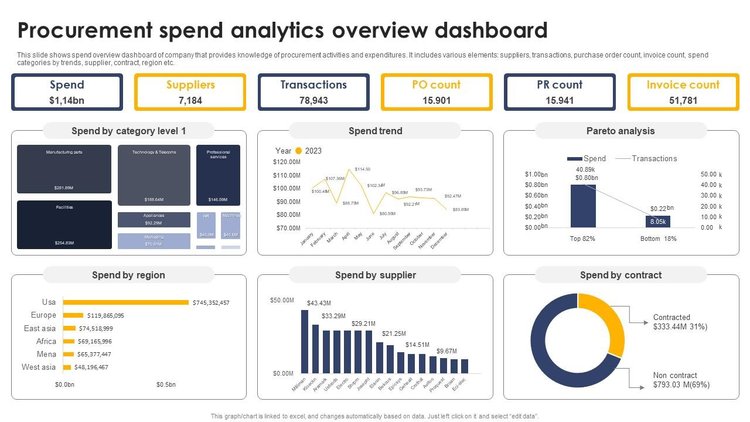Sourcing and Procurement Data Analytics: CaseWhen Consulting
Harness the Power of Your Procurement Data
Enhance Supplier Management: Gain real-time insights into supplier performance and relationships.
Optimize Procurement Processes: Streamline sourcing activities and reduce costs.
Mitigate Procurement Risks: Utilize predictive analytics to anticipate and mitigate procurement risks.
What is Sourcing and Procurement Data Analytics?
Sourcing and procurement data analytics involves the collection, analysis, and interpretation of data related to purchasing activities to drive strategic decisions. This practice enables organizations to improve supplier management, optimize procurement processes, and mitigate risks.
Example: A global manufacturer using procurement analytics to evaluate supplier performance and negotiate better terms, leading to cost savings and improved supplier reliability.
Key Components of Sourcing and Procurement Data Analytics
Data Collection
Sources: Gather data from procurement systems, supplier databases, and market intelligence platforms.
Tools: Use procurement software, data lakes, and analytics platforms to compile comprehensive data.
Data Analysis
Techniques: Apply statistical analysis, predictive modeling, and spend analysis to interpret procurement data.
Outcomes: Identify trends, optimize supplier selection, and enhance procurement strategies.
10 KPIs of Procurement Analytics
How is Analytics Used in Sourcing and Procurement?
Improved Supplier Management
Enhanced supplier management involves using data analytics to gain real-time insights into supplier performance and relationships. Analytics helps evaluate supplier reliability, quality, and compliance.
Example: Implementing supplier scorecards to assess performance metrics such as on-time delivery and defect rates, leading to better supplier selection and management.
Benefit: Improved supplier management enhances supplier relationships, reduces risks, and ensures consistent quality and delivery.
Optimized Procurement Processes
Optimizing procurement processes means using data analytics to streamline sourcing activities and reduce costs. Analytics helps identify inefficiencies and optimize procurement strategies.
Example: Using spend analysis to identify maverick spend and negotiate better terms with suppliers, resulting in cost savings and more efficient procurement operations.
Benefit: Streamlined procurement processes reduce cycle times, lower costs, and improve overall procurement efficiency.
Risk Management
Risk management in procurement involves using analytics to identify and mitigate potential risks related to suppliers and market conditions. Analytics can predict issues such as supplier financial instability or geopolitical risks, enabling proactive management.
Example: Applying predictive analytics to assess the impact of currency fluctuations on procurement costs and developing hedging strategies to mitigate risks.
Benefit: Proactive risk management minimizes the impact of supplier disruptions and market volatility, ensuring continuity of supply and stable procurement costs.
By leveraging sourcing and procurement data analytics, businesses can gain critical insights, optimize procurement operations, and manage risks more effectively, leading to improved procurement performance and competitive advantage.
CaseWhen's Innovative Approach
Unique Methodology for Procurement Analytics
At CaseWhen, we redefine sourcing and procurement analytics with an innovative methodology that surpasses traditional approaches. Our blend of advanced data analysis techniques and industry expertise provides actionable insights that drive strategic procurement decisions.
Advanced Analytics Techniques and Industry Expertise
What sets CaseWhen apart is the integration of cutting-edge analytics with deep procurement knowledge. This powerful combination offers a comprehensive understanding of your unique procurement challenges and opportunities, enabling us to develop tailored solutions that deliver measurable results.
Customized Solutions for Your Business
Recognizing that one-size-fits-all doesn’t work in procurement analytics, CaseWhen designs customized solutions that align with your specific procurement goals and requirements. Whether you need advanced spend analysis, supplier risk assessment, or procurement process optimization, we ensure our solutions are tailored to meet your business objectives.
Tailored Strategies: Solutions designed to meet your specific procurement needs.
Expert Insights:Leverage our deep industry knowledge for a competitive edge.
Proven Results: Enhance procurement performance with data-driven decisions.
Unlock the full potential of your procurement data with CaseWhen’s Sourcing and Procurement Data Analytics Service. Let us help you transform insights into actionable strategies that drive your business forward.



